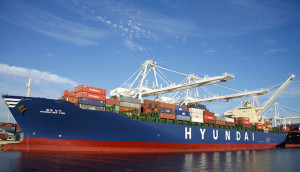
The number of trade lanes served by the Korean deep sea lines has decreased as well as their deployed capacity following Hanjin’s demise and Hyundai’s reduction in regions served, MDS Transmodal consultancy said in its latest review of non-alliance liners.
As explained, the non-alliance shipping lines are characterised by having fleets of smaller size vessels, operating in secondary trade lanes and secondary ports.
The shipping lines in question are Hyundai, SM Line, ZIM, PIL and Wan Hai, and they are present on the traditional East/West routes to varying degrees, in addition to other trade lanes.
The consultancy’s data from the second quarter of 2017, shows that, when compared to the corresponding quarter a year earlier, Korean lines have dropped their European and Mediterranean routes which constituted 16 percent of the previous capacity share by trade line. As a result, they expanded their presence in the Far East-North America trade to 39 percent from 24 percent, bolstered their presence in the Far East to 27 percent from 17 percent and Gulf and ISC-Far East to 32 percent from 21 percent.
While not a vessel provider to 2M, Hyundai takes up slots on its network and in return Maersk and MSC gain access to not only their transpacific network but also, for some, their Ultra-Large Container Ships (ULCs). 38% of Hyundai’s fleet (10,000teu+) has been chartered out to the 2M Alliance members who now operate these vessels. The remaining ULCs are now redeployed to the Far East- Mid East trades having operated on the Asia-Europe network last year. As a vessel operator Hyundai has pulled out of the Europe & Mediterranean trades whilst increasing its capacity on the Far East-Gulf & ISC and Intra-Asia lanes, the latter strengthened by the increasing cooperation of Korean shipping lines and the formation of the HMM+K2 and Mini Alliance.
Hanjin’s demise has led to its transpacific west coast operations coming into the hands of the newly formed SM Line which intends to enter east coast operations in 2018. The new carrier, which has also begun intra-Asia operations, has quickly acquired 17 containerships within just a few months; a number of these being former Hanjin tonnage. Whilst SM Line’s vessel acquisition policy has been rapid, the number of trade lanes it participates in is more cautious when compared to the extensive network seen by its predecessor Hanjin, MDS Transmodal added.
Speaking of the remaining three non-alliance carriers, since withdrawing from the highly competitive Asia- Europe trades, Israeli shipping line ZIM has become a global niche player. With vessels no larger than 10,000teu it has remained on trade lanes where it can compete and where size does not always matter.
In some instances, Zim calls into secondary or peripheral ports, such as Tarragona rather than Barcelona, Da Chan Bay as opposed to the bigger terminals such as Chiwan and Shekou. Panamax vessels remain the workhorse of its fleet, operating over 50 of the type at a time when the beleaguered sector has experienced a large number being sold for scrap over the past twelve months.
With the expansion of the Panama Canal and the raising of the Bayonne Bridge, Zim is in the process of introducing vessels of 8,200-10,000teu on its Far East – US East Coast, ‘ZCP’ service. Zim also has slot agreements on the Med-USEC trade lane with Hapag-Lloyd and THE Alliance whilst also takin space on the Hyundai’s transpacific PS2 loop.
Similarly, PIL could be bracketed as a niche line, deploying most of it tonnage to the Far East – Africa and Red Sea markets. It offers direct deep sea links from China/North Asia to East African ports in a market where bigger lines (and bigger ships) tranship at one of the Indian Ocean hubs. For the time being East African ports are not capable of serving large containerships so that PIL with its modest fleet largely of Panamax vessels can compete even with the likes of Maersk. Whilst these niche services are often run independently, PIL recently began cooperating as a vessel provider on the Transpacific West Coast alongside COSCO and Wan Hai.
Furthermore, PIL has additional access to the Transpacific with slots on Ocean Alliance services and with no fewer than 16 x 11,800teu vessels on order it also has plans of entering the Transpacific East Coast trade lane, the review further reads.
Wan Hai deploys over 50% of its deployed capacity to the intra-Asia markets reflected by its strong dependency on small feeder vessels, which it often operates on its own. Conversely, its deepsea operations are often characterised by being one of multiple operators (usually fellow East Asian lines) in a vessel sharing agreement. The majority of deep sea deployment is on the Far East-Indian Sub-Continent trade lane where there is a high dependency on Panamax vessels with some ISC ports restricted by drafts and hinterland connections, MDS Transmodal further noted.
Copyright Ships & Ports Ltd. Permission to use quotations from this article is granted subject to appropriate credit given to www.shipsandports.com.ng as the source.